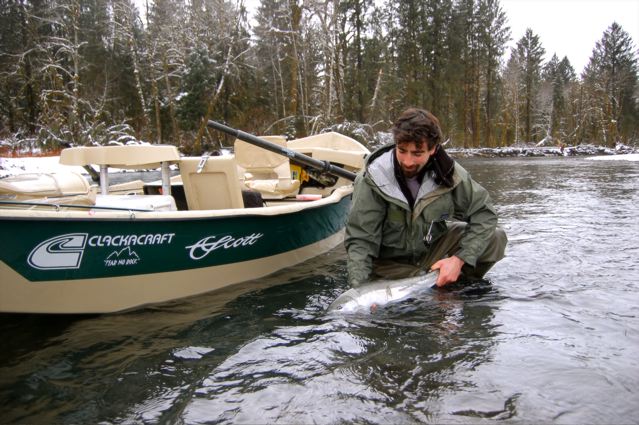Deep Thoughts, sink tips for steelhead fishing Vol. 1
No new report here, BECAUSE I’M IN MEXICO!
First of all, what sink tips do I like; Well here is the deal,
Unlike the Skagit, most of the Peninsula streams are small rocky fast and
shallow. Big long tips with long
compensators are difficult to control until they are well downstream of you in
this type of water. You need
something that will get the fly down fast and allow you to steer it with pin
point accuracy, you may not however need to keep it down there very long.
At times the best bet is a dry line with a heavy fly, or heaven
forbid a 3/0 Danielson mini-tip (split shot). More often however I run short tungsten tip off of a short
home made compensator.
I build my compensators by adding a loop to either end of a
piece of eight weight clear sinking, or “slime” line. Generally I fish about 6 feet of compensator attached to
about 5 feet of t-14.
The down side is that this rig will want to make your loop
close out when casting, the plus is that because of the slime line is much
skinnier and limper than the standard compensator it tends to balloon out in
the current much less. It also
allows you to mend directly to your sink tip so you can steer the fly with far
more accuracy.

The standard fat compensator anchors your mend, meaning that
with 5 feet of compensator and 12 feet of sink tip you have 17 feet of line
that will not be fully under your control until it is at least 45 degrees down
stream from you.
Now, if you are for instance fishing some great big giant
slow run where the current is fastest in the middle and gradually slows near
the bank, is about 5 feet deep and moving at a fast walk, the standard Skagit
set up suites the bill. The
problem is that if your on the Sol Duc, the best biters will be in shallow fast
riffles studded with big boulders and sticks that you have to high line over
and remend the whole line 3 times in a cast to get a 25 foot swing.
Lastly, a lot of Skagit lines are hot yellow with white/grey
compensators; these are very high Vis colors in clear water and close quarters
fishing. A clear compensator
allows you to keep that day glow stuff a little farther from the fish.
Jim Kerr


Very Informative. Makes too much sense though…thanks
That really confused me. You didnt mention one thing about bobbers.
The bobber goes in your pocket. When you are ready to catch a steelhead you put it on your leader. That is the signal, when they see it they bite.
Is that some sort of ploy to imply that I bobber fish alot?
I am still confused.
How do you know when to take the bobber out of your pocket?
As I clearly stated you take out the bobber when you are ready to catch one, it works right away. When you are ready to be done casting and want to pull in a big fish, just put on the bobber, the steelhead will see the bobber and know exactly what to do.
Does it matter what color bobber you put on your string?
What if they like the bobber so much they eat that?
Someone should make a bobber with a hook in it.